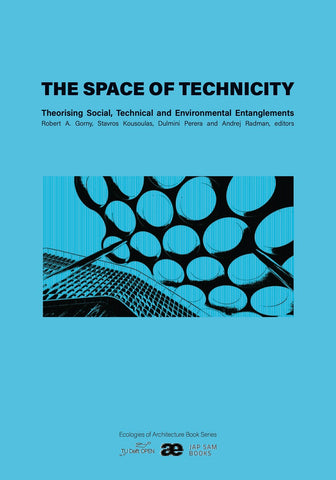Your cart is currently empty!
The Space of Technicity
+++Theorising Social, Technical and Environmental Entanglements+++
+++Robert Gorny, Stavros Kousoulas, Dulmini Perera, Andrej Radman [eds.]+++
ISBN 978-94-93329-14-0
Price € 39.95
Series editors Stavros Kousoulas, Andrej Radman, Heidi Sohn, Department of Architecture, Faculty of Architecture and the Built Environment, TU Delft
Volume editors Robert A. Gorny, Stavros Kousoulas, Dulmini Perera, Andrej Radman
Copy editor Heleen Schröder
Layout editor Lena Galanopoulou
Cover image Marc Boumeester
Number of pages 268
Book size 16,8 x 24 cm
Binding Softcover
Printer ORO Grafisch Project Management
Language English
Release date 1 juni 2024
Publisher Jap Sam Books, TU Delft OPEN Publishing
The Ecologies of Architecture Book Series is published by TU Delft OPEN Publishing and Jap Sam Books in collaboration with the Architecture Philosophy and Theory Group, Faculty of Architecture and the Built Environment, TU Delft.
+++
Desperate times demand optimistic transdisciplinary measures. This volume unites a select group of thinkers who courageously traverse disciplinary boundaries. What brings them together is the least stratified ‘component’: a shared problem. It is a widely recognised that a problem gets the solution it merits. However, only a few acknowledge that a problem seldom neatly fits within a single discipline, nor does it conform to the principle of general equivalence. Handling its irreducibility and non-entailment is a skill possessed by very few. Even fewer take the quasi-causal capacity of what we term the ‘space of technicity’ seriously.
The space of technicity, the shared problem of this volume, is a consequence of immanence. Each configuration of surfaces comprising the built environment produces an intangible effect, acting as a quasi-cause. It can be referred to as downward causation or the timely rediscovery of (neo)finalism.
In this volume it approached it from the perspective of axiology. The space of technicity allows us to evade techno-determinism without adopting an anything-goes attitude. That which has become manifest could have individuated differently. However, the potential of a body cannot be discerned before intervening in the causal fabric of agential reality to extract the singular points that make certain outcomes more likely than others, surpassing mere probability.
The Ecologies of Architecture Book Series promotes a transdisciplinary approach to architectural thinking and doing by extending its interest to topics that bring together the three ecological registers, namely the environment, the social and the individual. Such an approach accounts for what the built environment will come to be, and speculates about who will become alongside it. The series focuses not only on the why, what and how of architecture, but also on the who, who with and for whom.
Theorising Social, Technical and Environmental Entanglements
€39.95
The Space of Technicity
Theorising Social, Technical and Environmental Entanglements
€39.95
Architecture / Bookazines / Series / New titles / Theory
ISBN 978-94-93329-14-0
Price € 39.95
Series editors Stavros Kousoulas, Andrej Radman, Heidi Sohn, Department of Architecture, Faculty of Architecture and the Built Environment, TU Delft
Volume editors Robert A. Gorny, Stavros Kousoulas, Dulmini Perera, Andrej Radman
Copy editor Heleen Schröder
Layout editor Lena Galanopoulou
Cover image Marc Boumeester
Number of pages 268
Book size 16,8 x 24 cm
Binding Softcover
Printer ORO Grafisch Project Management
Language English
Release date 1 juni 2024
Publisher Jap Sam Books, TU Delft OPEN Publishing
The Ecologies of Architecture Book Series is published by TU Delft OPEN Publishing and Jap Sam Books in collaboration with the Architecture Philosophy and Theory Group, Faculty of Architecture and the Built Environment, TU Delft.
Desperate times demand optimistic transdisciplinary measures. This volume unites a select group of thinkers who courageously traverse disciplinary boundaries. What brings them together is the least stratified ‘component’: a shared problem. It is a widely recognised that a problem gets the solution it merits. However, only a few acknowledge that a problem seldom neatly fits within a single discipline, nor does it conform to the principle of general equivalence. Handling its irreducibility and non-entailment is a skill possessed by very few. Even fewer take the quasi-causal capacity of what we term the ‘space of technicity’ seriously.
The space of technicity, the shared problem of this volume, is a consequence of immanence. Each configuration of surfaces comprising the built environment produces an intangible effect, acting as a quasi-cause. It can be referred to as downward causation or the timely rediscovery of (neo)finalism.
In this volume it approached it from the perspective of axiology. The space of technicity allows us to evade techno-determinism without adopting an anything-goes attitude. That which has become manifest could have individuated differently. However, the potential of a body cannot be discerned before intervening in the causal fabric of agential reality to extract the singular points that make certain outcomes more likely than others, surpassing mere probability.
The Ecologies of Architecture Book Series promotes a transdisciplinary approach to architectural thinking and doing by extending its interest to topics that bring together the three ecological registers, namely the environment, the social and the individual. Such an approach accounts for what the built environment will come to be, and speculates about who will become alongside it. The series focuses not only on the why, what and how of architecture, but also on the who, who with and for whom.
v


















